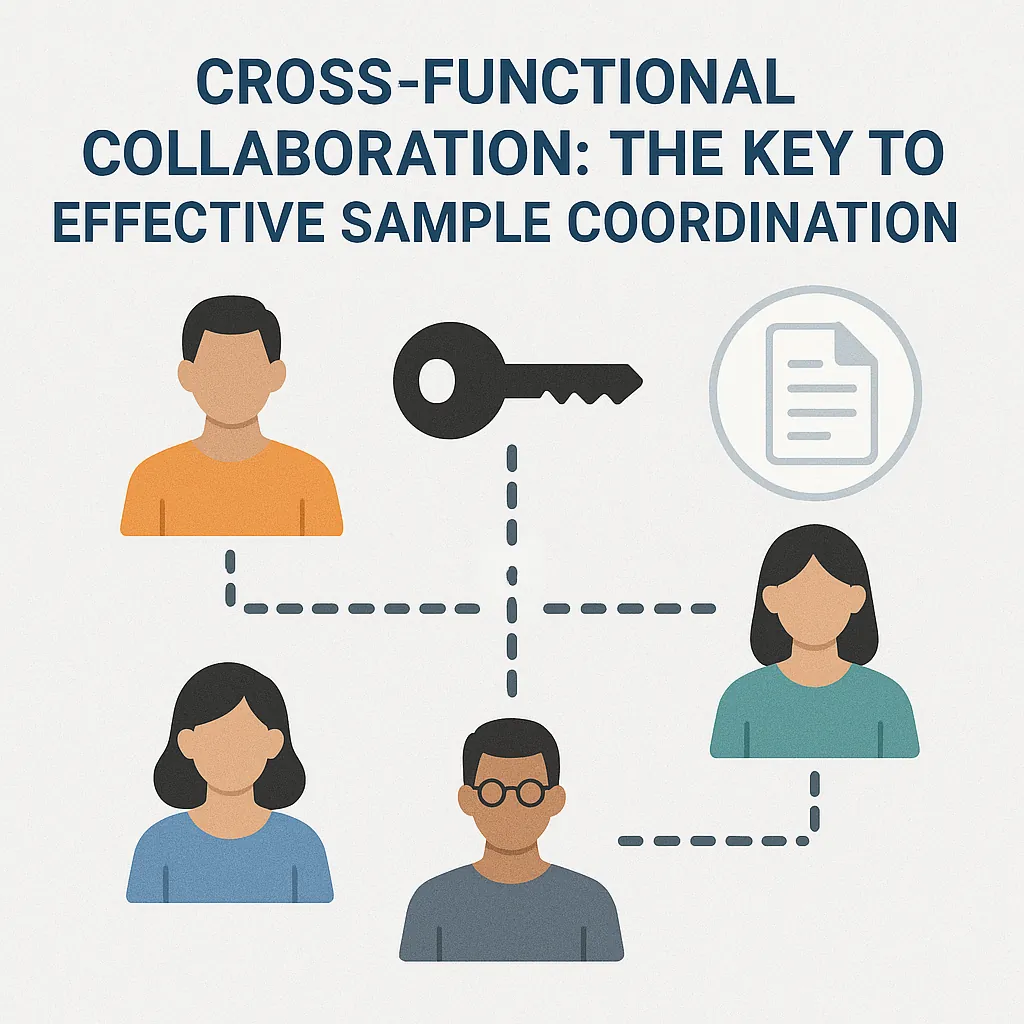Introduction to Sample Coordination
Sample coordination is a critical aspect of project management that involves the systematic organization and management of samples—whether they are physical products, data sets, or prototypes—throughout the project lifecycle. This process ensures that samples are collected, analyzed, and utilized effectively to meet project objectives.
Definition of Sample Coordination
Sample coordination refers to the process of managing and overseeing the collection, handling, and distribution of samples within a project. It encompasses various tasks, including planning sample requirements, ensuring proper documentation, and facilitating communication among team members involved in sample management. By establishing clear protocols and responsibilities, sample coordination helps streamline workflows and enhances the overall efficiency of project execution.
Importance of Effective Sample Coordination in Project Success
Effective sample coordination is vital for the success of any project, as it directly impacts the quality and reliability of the outcomes. When samples are managed properly, teams can:
- Ensure Quality Control: Proper coordination helps maintain the integrity of samples, which is essential for accurate analysis and decision-making.
- Facilitate Timely Decision-Making: By having samples readily available and well-documented, teams can make informed decisions quickly, reducing delays in project timelines.
- Enhance Communication: Clear coordination fosters better communication among team members, ensuring that everyone is aligned on sample requirements and expectations.
Overview of Cross-Functional Collaboration in Sample Management
Cross-functional collaboration plays a pivotal role in enhancing sample management within projects. This approach involves bringing together individuals from various departments—such as research, marketing, and operations—to work collectively towards a common goal. The benefits of cross-functional collaboration in sample management include:
- Diverse Expertise: Team members from different functional areas contribute unique perspectives and skills, leading to more innovative solutions and improved sample handling processes.
- Breaking Down Silos: Collaboration encourages the exchange of ideas and knowledge, which helps eliminate barriers that often hinder effective sample management.
- Streamlined Processes: By working together, teams can develop more efficient workflows for sample collection, analysis, and reporting, ultimately leading to better project outcomes.
The Role of Cross-Functional Teams
Particularly in sample coordination, the role of cross-functional teams is paramount. These teams consist of individuals from various departments or areas of expertise who come together to achieve a common goal. The diversity in skills and perspectives within these teams can significantly enhance the effectiveness of sample management processes.
Understanding Cross-Functional Teams
- Composition: Cross-functional teams are typically made up of members from different functional areas such as marketing, research and development, quality assurance, and supply chain management. This diversity allows for a more holistic approach to problem-solving and decision-making, as each member brings unique insights and expertise to the table [12].
Benefits of Diverse Expertise in Sample Management
- Enhanced Problem Solving: The varied backgrounds of team members foster innovative solutions to challenges that may arise during sample coordination. For instance, a team member from quality assurance may identify potential compliance issues that others might overlook, ensuring that all samples meet necessary standards [13].
- Improved Communication: Cross-functional collaboration minimizes communication barriers, as team members are encouraged to share information and updates regularly. This open line of communication helps keep all stakeholders aligned and informed, reducing the likelihood of misunderstandings and errors [11].
- Increased Efficiency: By leveraging the strengths of each team member, cross-functional teams can streamline processes and improve overall project efficiency. For example, integrating project management tools like Asana can help manage workflows and reduce email volume, leading to a more organized approach to sample coordination [2].
Case Studies of Successful Cross-Functional Collaboration
- Healthcare Project Example: A strategic project in the healthcare sector involved a cross-functional team that included clinicians, data analysts, and project managers. By collaborating closely, they were able to optimize sample collection processes, resulting in a 20% improvement in project efficiency. This success was attributed to the diverse expertise that allowed for comprehensive planning and execution [8].
- Consumer Product Launch: In a recent product launch, a cross-functional team comprising marketing, product development, and logistics worked together to manage sample distribution effectively. Their collaboration led to a 35% reduction in project cycle times, demonstrating how diverse skills can lead to significant improvements in sample management [2].
Challenges in Sample Coordination
Effective sample coordination is crucial in project management, particularly when it involves cross-functional teams. However, several challenges can hinder the smooth management of samples. Here are some of the most common issues faced in sample coordination:
- Communication Barriers Among Teams: One of the primary challenges in sample coordination is the lack of effective communication between different teams. Misunderstandings can arise due to varying terminologies, communication styles, or even the tools used for collaboration. This can lead to delays in sample delivery, incorrect sample specifications, and ultimately, project setbacks. Establishing clear communication channels and regular updates can help mitigate these issues.
- Misalignment of Goals and Priorities: Different teams often have distinct objectives and priorities, which can lead to conflicts in sample management. For instance, while one team may prioritize speed in sample delivery, another may focus on quality. This misalignment can result in compromised sample quality or delays in project timelines. To overcome this challenge, it is essential to align team goals through collaborative planning sessions and ensure that all stakeholders understand the project’s overarching objectives.
- Resource Limitations and Their Impact on Sample Quality: Resource constraints, whether in terms of budget, personnel, or time, can significantly affect sample quality. Limited resources may lead to rushed processes, inadequate testing, or insufficient documentation, all of which can compromise the integrity of the samples. To address this challenge, project managers should conduct thorough resource assessments and allocate resources strategically to ensure that sample quality is not sacrificed for the sake of expediency.
By recognizing and addressing these challenges, teams can enhance their collaboration and improve the overall effectiveness of sample coordination in project management.
Strategies for Enhancing Collaboration
Particularly in sample coordination, cross-functional collaboration is essential for achieving efficiency and effectiveness. By fostering a collaborative environment, teams can streamline processes, enhance communication, and ultimately improve sample management. Here are some actionable strategies to enhance collaboration among teams:
- Creating a Culture of Open Communication: Establishing transparent communication channels is fundamental for effective collaboration. Encouraging team members to share their thoughts, concerns, and feedback openly can lead to better understanding and alignment on project goals. Regular check-ins and updates can help keep everyone informed and engaged, ensuring that all voices are heard and valued [7][13].
- Utilizing Project Management Tools for Better Coordination: Implementing collaborative tools can significantly enhance coordination among team members. Tools like Slack, Trello, or Asana allow teams to manage tasks, share updates, and track progress in real-time. These platforms facilitate seamless communication and ensure that everyone is on the same page, which is crucial for managing samples effectively [6][10].
- Establishing Clear Roles and Responsibilities Among Team Members: Defining specific roles and responsibilities is vital for minimizing confusion and ensuring accountability within cross-functional teams. When team members understand their individual contributions to the project, it fosters a sense of ownership and encourages collaboration. This clarity helps in aligning efforts towards common objectives, ultimately leading to more successful sample management [9][12].
By implementing these strategies, team leaders and collaboration specialists can create a more cohesive and productive environment that enhances sample coordination in projects. Emphasizing open communication, leveraging project management tools, and clarifying roles will not only improve collaboration but also drive better project outcomes.
Best Practices for Effective Sample Management
Effective sample coordination in project management is crucial for ensuring that teams can work together seamlessly, especially when dealing with samples that require input from various departments. Here are some best practices that can enhance collaboration and improve sample management:
- Regular Check-Ins and Updates Among Teams: Establishing a routine for check-ins allows team members to stay aligned on project goals and sample requirements. Regular updates help in identifying any potential issues early on, ensuring that all teams are informed about the status of samples and any changes in project direction. This practice fosters accountability and keeps everyone on the same page, which is essential for successful sample coordination [2][12].
- Documenting Processes and Decisions for Clarity: Clear documentation of processes and decisions is vital for effective sample management. By maintaining comprehensive records, teams can refer back to previous discussions and agreements, reducing misunderstandings and ensuring that everyone is aware of their responsibilities. This practice not only enhances transparency but also serves as a valuable resource for onboarding new team members or revisiting past projects [10][12].
- Leveraging Feedback Loops to Improve Sample Handling: Implementing feedback loops allows teams to continuously improve their sample management processes. By encouraging team members to share their insights and experiences, organizations can identify best practices and areas for improvement. This collaborative approach not only enhances the quality of sample handling but also fosters a culture of open communication and collective ownership among team members [11][12].
By integrating these best practices into sample coordination efforts, project teams can enhance their collaboration, leading to more efficient and effective management of samples throughout the project lifecycle.
Measuring the Success of Collaboration in Sample Coordination
Effective sample coordination in project management hinges on robust cross-functional collaboration. To ensure that teams work seamlessly together, it is essential to measure the success of their collaborative efforts. This section will delve into the key performance indicators (KPIs) and metrics that can assess collaboration effectiveness in sample management.
Identifying Key Performance Indicators for Sample Management
To gauge the effectiveness of collaboration in sample coordination, organizations should establish specific KPIs that reflect both the quality and efficiency of teamwork. Some critical KPIs include:
- Communication Frequency and Quality: Regular and clear communication among team members is vital. Tracking the frequency of meetings, emails, and updates can provide insights into how well teams are collaborating [1].
- Project Completion Rates: Monitoring the rate at which samples are completed and delivered can indicate the efficiency of collaboration. A higher completion rate often correlates with effective teamwork [1].
- Knowledge Sharing: Assessing how well teams share information and resources can highlight the collaborative spirit within the organization. This can be measured through surveys or feedback mechanisms [1][10].
- Turnaround Time for Sample Requests: Measuring the time taken from sample request to delivery can help identify bottlenecks in the collaboration process. A decrease in turnaround time may suggest improved teamwork [14].
Quantitative and Qualitative Measures of Success
To comprehensively evaluate collaboration in sample coordination, both quantitative and qualitative measures should be employed:
- Quantitative Measures: These include numerical data such as the number of samples processed, adherence to deadlines, and budget variance. For instance, tracking the Cost Performance Index can provide insights into financial efficiency related to sample management [9][6].
- Qualitative Measures: Gathering feedback through surveys or interviews can help assess team satisfaction and the perceived effectiveness of collaboration. Understanding team members’ experiences can reveal areas for improvement that numbers alone may not capture [15].
Adjusting Strategies Based on Performance Data
Once KPIs and metrics are established, it is crucial to analyze the data regularly to inform strategic adjustments. This involves:
- Data Analysis: Regularly reviewing performance data allows teams to identify trends and areas needing improvement. For example, if communication quality is low, teams may need to implement more structured communication protocols [12].
- Feedback Loops: Creating mechanisms for continuous feedback can help teams adapt their strategies in real-time. This could involve regular check-ins or retrospective meetings to discuss what is working and what is not [14].
- Iterative Improvements: Based on the insights gained from performance data, teams should be willing to iterate on their processes. This could mean refining collaboration tools, adjusting team roles, or enhancing training programs to foster better teamwork [10][12].
Conclusion: The Future of Sample Coordination
Particularly in sample coordination, cross-functional collaboration emerges as a pivotal element that significantly enhances efficiency and effectiveness. By bringing together diverse expertise and perspectives, teams can streamline processes, improve communication, and ultimately achieve better project outcomes. Here’s a recap of the benefits of cross-functional collaboration in sample management:
- Enhanced Communication: Open channels of communication foster a culture of transparency and trust among team members, which is essential for effective sample coordination. This leads to quicker decision-making and problem-solving, as all stakeholders are aligned and informed [2][6].
- Diverse Skill Sets: Cross-functional teams leverage a unique mix of skills and talents, allowing for innovative solutions to arise. This diversity not only enriches the project but also empowers team members to contribute their best work [5][8].
- Improved Workflow: A structured collaboration framework can drive clear communication and shared expectations, resulting in smoother workflows. This is particularly important in sample management, where timely and accurate handling of samples is crucial [6][10].
- Increased Productivity: By coordinating efforts across various functions, teams can reduce redundancies and enhance productivity. For instance, integrating project management tools can streamline communication processes, leading to significant improvements in project cycle times and overall team performance [10].
As we look to the future of sample coordination, it is essential for team leaders and collaboration specialists to embrace these collaborative practices. Continuous improvement should be a priority, with a focus on:
- Adopting Agile Methodologies: Agile project management can further enhance cross-functional collaboration by promoting iterative processes and flexibility, allowing teams to adapt quickly to changes and challenges [10].
- Investing in Technology: Utilizing advanced project management tools and platforms can facilitate better communication and coordination among team members, making sample management more efficient and effective [10].
- Fostering a Collaborative Culture: Encouraging a culture that values collaboration and teamwork will not only improve sample management but also contribute to a more engaged and motivated workforce.
In conclusion, the future of sample coordination lies in the hands of those who prioritize collaboration. Team leaders and collaboration specialists are encouraged to champion these practices, ensuring that their teams are equipped to navigate the complexities of project management successfully. By doing so, they will not only enhance sample management but also drive overall project success.
Find out more about Shaun Stoltz https://www.shaunstoltz.com/about/.
This post was written by an AI and reviewed/edited by a human.



